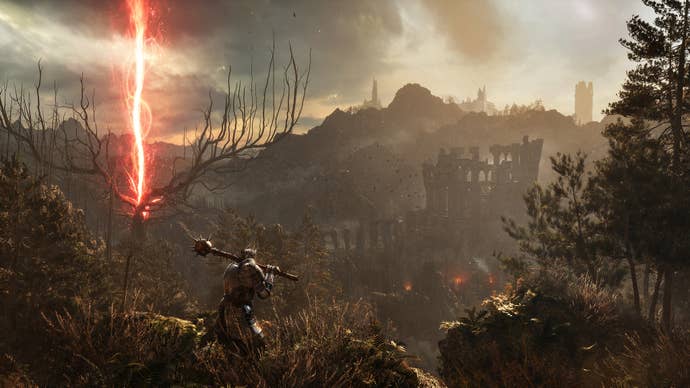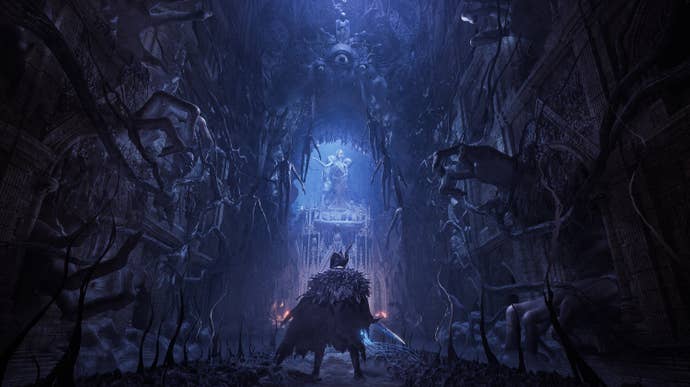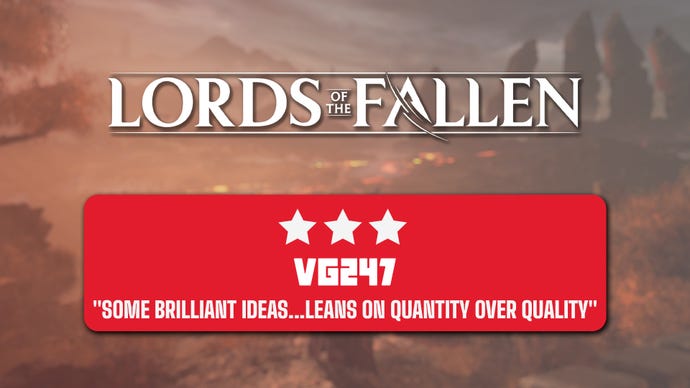Lords of the Fallen review: fertile ground for a sequel, but leaves a lot to be desired
I really wanted to like Lords of the Fallen more than I did, as much as it impressed me in parts.
My time with Lords of the Fallen started out very positive, but it was disheartening to see my opinion on it turn the more of it I played. It’s a game with some genuinely brilliant ideas, and a high-level vision of how to set itself apart from other Souls-likes. But that vision did not seem to have been shared by everyone on the team.

Lords of the Fallen is a Souls-like. If you played any of those before, you immediately expect a few basic features. Combat is stamina-based; heavier weapons/attacks use up more of it than lighter ones. Your rolls and dodges rely on the same stamina pool, and you’re given ranged options in the form of throwables, weapons like bows, and magic spells.
Wither damage is one mechanic that’s not very common among those games. Blocking does not negate damage entirely, but instead turns the portion of it received to what the game calls Wither, represented by a grey colour on your health bar. You can regain that lost health by simply landing attacks on your opponent, but take one hit, and you lose it all.
Wither damage is likely the first thing you’ll notice taking upon entering Umbral, the game’s parallel world of the dead. Lords of the Fallen’s main mechanic is that its world exists on two planes. Axiom is the realm of the living, and it’s where you start. Die, and you fall into Umbral.
Both are always present, and the Umbral Lamp you get from the off lets you peer through (and travel to it) anytime you want. The game uses this in a few clever ways that I’ve not seen before in other Souls-likes. For one thing, Umbral acts as a second life after dying, which offers another chance at either finishing the fight (if it’s a boss), or abandoning it.

But this comes at a cost. Not only do you take Wither damage immediately upon landing in Umbral, the world of the dead is much more treacherous. Umbral mobs roam around right alongside enemies from Axiom, and the longer you stay there, the more challenging things will get.
The game actually wants you to farm your Vigor (Souls) in Umbral. There’s a multiplier that makes it a bit easier to farm, but your ability to say enough is enough and leave Umbral will be tested, as more hunter-like enemies begin chasing you the longer you spend there. Getting out of Umbral can mainly be done at certain, pre-made points, the placement of which can turn a good run into a disaster.
Speaking of checkpoints, Lords of the Fallen lets you create your own in either world. These seeds can be earned by defeating enemies, or bought outright from a certain NPC. You can only have one of them active at a time, so they serve as temporary checkpoints, if placed before boss fights or placed deeper into the level. I found them to be helpful but only as a bandaid for the game’s lack of consistent checkpointing, especially for the larger, late-game levels. Levels do have shortcuts, so I’m not necessarily asking for a Vestige (bonfire) right outside the fog gate (though that would help), more that HexWorks needs to reevaluate where checkpoints are placed for large parts of the game.
The other thing Umbral represents is an opportunity for more elaborate level design. You’ll regularly come across sections that can only be reached by going to Umbral. Sometimes those allow you to unlock shortcuts for future runs in Axiom, but they mostly exist to let you explore areas of the world you didn’t know existed.
The challenge is heightened in Umbral, of course, and it’s another thing that can turn frustrating when you’re asked to do some platforming as you dodge archers and wizards at four different angles while trying to outrun the mobs on your tail.

Lords of the Fallen’s biggest problem is encounter design. In simple terms: you’ll be consistently hounded by more enemies than you can handle, and they’re often given advantages that immediately put you on the back foot.
Snipers have been a major pain point, and though HexWorks has already adjusted them over the course of my time with the game, they remain unfair. Ranged enemies have exceedingly long range awareness of the player, with a near-100% hit rate. Because of various visual effects, you rarely see them before they see you, so you often take two hits just as you turn a corner, forcing you to immediately retreat without even realising the attackers’ approximate location.
The game has a similar approach to melee enemies, who always have more numbers than Lords of the Fallen’s combat is built to handle. They never lose track of you, and never stop chasing you. At the height of my frustration with it, I would simply run past entire areas just to get to where I was before dying, only to have to deal with a dozen enemies all chasing me to my inevitable death.
Another way that misunderstanding of difficulty manifests is in the regular re-use of bosses as normal enemies. This is actually fairly common for Souls-likes, and it’s usually an easy way to show players how far they’ve grown in power over the course of the game. If you struggled with a certain boss, and hours later find it roaming around the open world, you’re going to feel good when you take it down with little resistance.
Except, in LOTF’s case, those bosses are immediately added to the enemy pool, making me question why they were bosses in the first place. It does the opposite of the intended effect, and makes you feel underpowered as a result.

Bosses, boss design, and even their entrances are all obviously major components of Souls-likes. The quality of bosses in Lords of the Fallen varies to a shocking degree, almost as if some of them were given the care and attention you want, and the rest got outsourced to meet a quota. The frequency of boss fights is somewhat responsible for that. So many times you’d be exploring the world, turn a corner and immediately see a health bar appear at the bottom of your screen without warning. It happens so often that it genuinely makes it hard to explore at your own pace, and adds to the frustration if you end up dying and having to constantly run back to pick up your dropped, forever-trapped Vigor.
The major story bosses are fairly straightforward, but they lean a little too much on spectacle over mechanical complexity. They almost always have one major area-clearing attack that’s guaranteed to kill you if you don’t know the specific way of avoiding it. It comes across as gimmicky.
Lords of the Fallen is a game of uneven quality. At its best, it offers level design, bosses, and combat that’s generally up there among the best Souls-likes. At its – more often – worst, it leans hard on quantity over quality, and a fundamental misunderstanding of what makes those games challenging. My issues with its balance and difficulty can improve with patches, and my misgivings about its design pitfalls are the sort of thing that sequels improve on all the time. It’s left me wanting to play Lords of the Fallen 2.
Version tested: PS5. Code provided by publisher.
